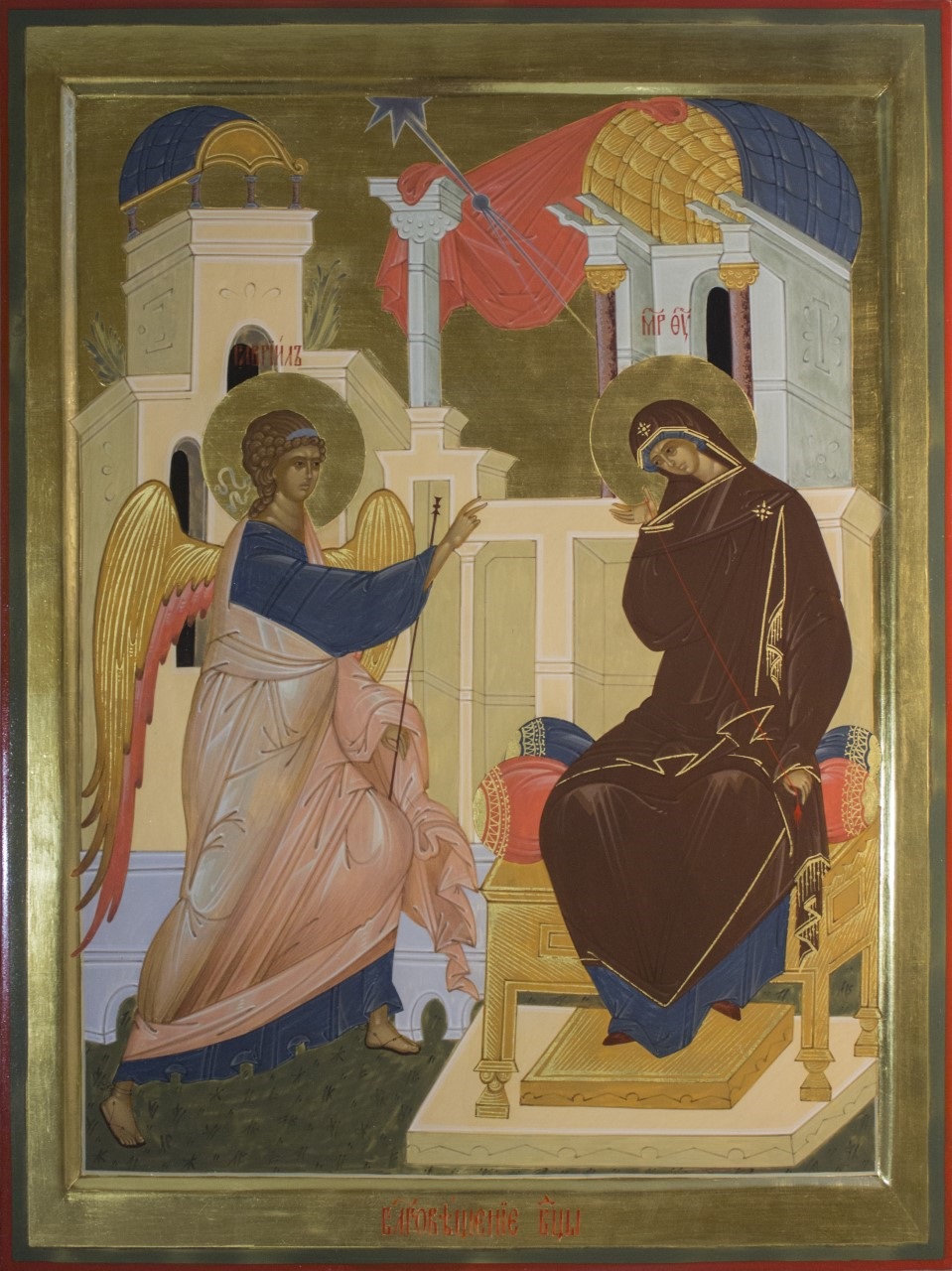With the Archangel’s voice we cry to thee, O most-pure one: Rejoice, thou who art full of grace, the Lord is with thee.

Dear brothers and sisters,
Поздравление с Благовещением!
Greetings to you all, as we celebrate the feast of the Annunciation, joining with the Archangel Gabriel in saluting the Mother of God, as we say, “Rejoice, thou who art full of grace” .
On Saturday, we shall add to this greeting with the many salutations of the Akathist Hymn, and the hymns of the feast and laudations in the Akathist remind us that the Incarnation of the God-Man, on the day of the Annunciation was not a sudden or random event, but one ordained since the fall of the first father and first mother. The Virgin’s fiat, in which she bowed to the will of God was a moment of cosmic change, which would find its fruition in the victorious death and resurrection of the Saviour conceived at that moment.
After the fall of Adam and Eve, in the protoevangelium of the third chapter of Genesis, God says to the serpent-tempter, “Because you have done this… I will put enmity between you and the woman, and between your offspring and hers; he will crush your head, and you will strike his heel.”
The Church Fathers saw this as the prophecy of the Incarnation, in which the Second Eve would give birth to Christ, the New Adam who would crush Satan, hell and death beneath His feet, though He Himself would suffer torture and death on the Cross, as the devil struck at His heel, but to no avail.
In the events of the Annunciation and obedience of the Mother of God, the promise of salvation became an unfolding reality in time and space, as God clothed Himself in Adam, united to His fallen children as He joined humanity to His divinity in a perfect union.
In the compline hymns of the feast, we celebrate the remedy of the fall and the reversal of the tragedy of Adam and Eve’s disobedience, as we chant,
“Behold, our restoration hath now been revealed to us! God uniteth Himself to men in manner past recounting! Falsehood is dispelled by the voice of the archangel! For the Virgin receiveth joy, an earthly woman hath become heaven! The world is released from the primal curse! Let creation rejoice and chant aloud: O Lord, our Creator and Deliverer, glory be to Thee!”
In the first ode of the Akathist Canon we call the Mother of God “the vessel of joy, through which the curse of the first mother is annulled” and “the restoration of Adam and death of hell”, and in the first ikos of the Akathist we shall offer laudations to the Mother of God singing,
“Rejoice, thou through whom joy shall shine forth;
Rejoice, thou through whom the curse shall cease.
Rejoice, raising of fallen Adam;
Rejoice, redemption of the tears of Eve.”
We shall soon see the visual realisation of these words in the icon of Pascha, as the Saviour descends into Hades, and frees Adam and Eve, and all of their righteous seed from the captivity of death, opening the gates of eternal life through His life-giving death and resurrection. The place of the Mother of God in this is celebrated in the Akathist, as we sing,
Rejoice, for through thee, paradise was opened;
Rejoice, key of Christ’s Kingdom.
But this is not the earthly paradise, from whose gates the flaming seraph is turned aside by the obedience of the Mother of God, as she says, “Behold the handmaid of the Lord, be it unto me according to Thy word”, but rather the heavenly paradise of the Heavenly Kingdom, itself.
This is why we celebrate this feast as “The beginning of our salvation and the manifestation of the eternal mystery.”
Why?
The next line of the troparion makes it clear – because “The Son of God becometh the Son of the Virgin…” and in so doing has united divinity and humanity, heaven and earth, creator and creation, or in the words of the aposticha,
“Those below are united to those above! Adam is restored, and Eve is freed from her primal grief! The tabernacle of our nature, mingled with divinity, hath become the temple of God! O the mystery! Incomprehensible is the image of His abasement, and ineffable the richness of His goodness!”
Celebrating this almost unthinkable and unimaginable wonder, let us heed the continuing words of the hymn, in awe and wonder for the Mother of God, who became an instrument of our salvation, as the Womb of the Divine Incarnation; the heavenly ladder by which God came down; the bridge leading from earth to heaven; and the opening of the doors of paradise:
“…let us cry out together with Gabriel to the Virgin: Rejoice, O joyous one, from whom Christ God, our salvation, is come, assuming our nature and elevating it in Himself! Him do thou entreat, that our souls be saved.”
May God bless you all!
In Christ – Hieromonk Mark